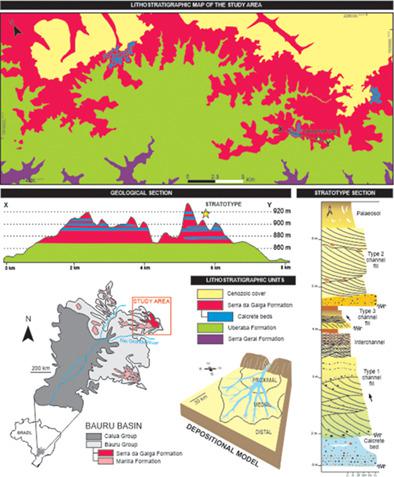当前位置:
X-MOL 学术
›
Geolog. J.
›
论文详情
Our official English website, www.x-mol.net, welcomes your
feedback! (Note: you will need to create a separate account there.)
Sedimentology of a distributive fluvial system: The Serra da Galga Formation, a new lithostratigraphic unit (Upper Cretaceous, Bauru Basin, Brazil)
Geological Journal ( IF 1.4 ) Pub Date : 2020-09-14 , DOI: 10.1002/gj.3987 Marcus Vinícius Theodoro Soares 1 , Giorgio Basilici 1, 2 , Thiago Silva Marinho 3, 4 , Agustín Guillermo Martinelli 5 , André Marconato 6 , Nigel Philip Mountney 7 , Luca Colombera 7 , Áquila Ferreira Mesquita 1 , Julia Tucker Vasques 1 , Francisco Romero Abrantes Junior 1 , Luiz Carlos Borges Ribeiro 4
Geological Journal ( IF 1.4 ) Pub Date : 2020-09-14 , DOI: 10.1002/gj.3987 Marcus Vinícius Theodoro Soares 1 , Giorgio Basilici 1, 2 , Thiago Silva Marinho 3, 4 , Agustín Guillermo Martinelli 5 , André Marconato 6 , Nigel Philip Mountney 7 , Luca Colombera 7 , Áquila Ferreira Mesquita 1 , Julia Tucker Vasques 1 , Francisco Romero Abrantes Junior 1 , Luiz Carlos Borges Ribeiro 4
Affiliation

|
The Bauru Basin of SE Brazil is a large (ca. 370,000 km2) Upper Cretaceous intracratonic feature, important for its fossil remains and of particular value as a source of regional palaeoclimatic information. Historically, lithostratigraphic reconstructions have been performed mainly for successions of the central and southern parts of the basin, resulting in a lithostratigraphic scheme that is not applicable to the northernmost regions. In particular, the northeastern deposits of the Marília Formation (Serra da Galga and Ponte Alta members) reveal lithological, stratigraphic, and palaeontological differences from southeastern and northwestern counterparts (Echaporã Member). Nevertheless, these deposits are considered as a single lithostratigraphic formation in the literature. To address this problem, this study demonstrates how the northeastern deposits of the Marília Formation do not show affinity to the rest of the unit. A more suitable lithostratigraphic model is proposed for the northeastern succession as a distinct and independent unit. Lithofacies and palaeopedological analysis, combined with lithostratigraphic mapping of the northeastern deposits, reveal 11 distinct lithofacies and three pedotypes over an area of ~450 km2. Sedimentary facies and pedotypes were assigned to six interbedded architectural elements: (a) type 1 channel fill, (b) type 2 channel fill, (c) type 3 channel fill, (d) interchannels, (e) palaeosols, and (f) calcrete beds. The succession is interpreted as a distributive fluvial system with overall direction of flow to the NNW, and which developed under the influence of a semiarid climate regime. This contrasts with deposits of the southeastern and northwestern Marília Formation, previously suggested to be of fine‐grained aeolian affinity with interbedded poorly channelised deposits assigned to an aeolian sand sheet environment. By revising the existing lithostratigraphic scheme for the northeastern deposits, and contrasting them with laterally equivalent strata, this work demonstrates how the previously named Serra da Galga and Ponte Alta members reveal a unique set of lithological, architectural, and genetic signatures that permits to separate them from the Marília Formation. Finally, a new lithostratigraphic classification for the unit is proposed: the Serra da Galga Formation, whose deposition relates to an ancient distributive fluvial system.
中文翻译:

分布式河床系统的沉积学:塞拉达加尔加组,一个新的岩石地层学单元(上白垩统,巴西包鲁盆地)
巴西东南部的Bauru盆地很大(约370,000 km 2)上白垩纪克拉通内部特征,对它的化石遗骸很重要,作为区域古气候信息的来源具有特殊价值。从历史上看,岩性地层重建主要是针对盆地中部和南部的演替而进行的,这导致了一个岩性地层学方案不适用于最北端的地区。特别是,玛丽亚组的东北沉积(Serra da Galga和Ponte Alta成员)揭示了与东南和西北对应部分(Echaporã成员)的岩性,地层和古生物学差异。然而,这些沉积物在文献中被认为是单一岩相地层。为了解决这个问题,这项研究表明了玛丽亚组东北部的沉积物如何不显示与该单元其余部分的亲和力。为东北演替提出了一个更合适的岩石地层学模型,作为一个独立的独立单元。岩相和古岩石学分析,结合东北矿床的岩石地层图,揭示了约450 km的区域中的11种岩相和3种岩型。2。沉积相和表型被分配给六个相互交错的建筑元素:(a)1型通道填充,(b)2型通道填充,(c)3型通道填充,(d)通道间,(e)古土壤和(f)钙质床。演替被解释为一个分布河流系统,其总流向NNW,是在半干旱气候体制的影响下发展的。这与东南和西北马里利亚组的沉积物形成对比,以前认为这些沉积物具有细粒的风积亲和力,而赋于风积砂岩环境的夹层通道性差的沉积物。通过修改现有的东北矿床岩石地层学方案,并将其与横向等效地层进行对比,这项工作展示了先前命名为Serra da Galga和Ponte Alta的成员如何揭示出一套独特的岩性,建筑学和遗传学特征,从而使它们与玛丽亚岩层分开。最后,提出了该单元的新岩性地层学分类:塞拉达加尔加组,其沉积与古代的分布式河流系统有关。
更新日期:2020-09-14
中文翻译:

分布式河床系统的沉积学:塞拉达加尔加组,一个新的岩石地层学单元(上白垩统,巴西包鲁盆地)
巴西东南部的Bauru盆地很大(约370,000 km 2)上白垩纪克拉通内部特征,对它的化石遗骸很重要,作为区域古气候信息的来源具有特殊价值。从历史上看,岩性地层重建主要是针对盆地中部和南部的演替而进行的,这导致了一个岩性地层学方案不适用于最北端的地区。特别是,玛丽亚组的东北沉积(Serra da Galga和Ponte Alta成员)揭示了与东南和西北对应部分(Echaporã成员)的岩性,地层和古生物学差异。然而,这些沉积物在文献中被认为是单一岩相地层。为了解决这个问题,这项研究表明了玛丽亚组东北部的沉积物如何不显示与该单元其余部分的亲和力。为东北演替提出了一个更合适的岩石地层学模型,作为一个独立的独立单元。岩相和古岩石学分析,结合东北矿床的岩石地层图,揭示了约450 km的区域中的11种岩相和3种岩型。2。沉积相和表型被分配给六个相互交错的建筑元素:(a)1型通道填充,(b)2型通道填充,(c)3型通道填充,(d)通道间,(e)古土壤和(f)钙质床。演替被解释为一个分布河流系统,其总流向NNW,是在半干旱气候体制的影响下发展的。这与东南和西北马里利亚组的沉积物形成对比,以前认为这些沉积物具有细粒的风积亲和力,而赋于风积砂岩环境的夹层通道性差的沉积物。通过修改现有的东北矿床岩石地层学方案,并将其与横向等效地层进行对比,这项工作展示了先前命名为Serra da Galga和Ponte Alta的成员如何揭示出一套独特的岩性,建筑学和遗传学特征,从而使它们与玛丽亚岩层分开。最后,提出了该单元的新岩性地层学分类:塞拉达加尔加组,其沉积与古代的分布式河流系统有关。











































 京公网安备 11010802027423号
京公网安备 11010802027423号